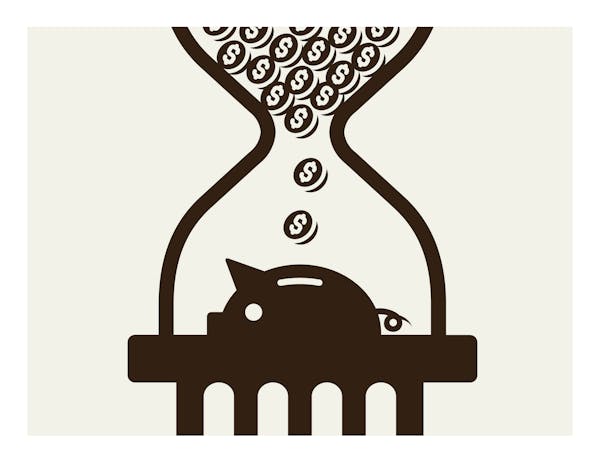Lisa Baker knows how to make the most of her budget when it comes to shopping for her children, and this year she has discovered an even cheaper way to ready her kids for their return to school: find it for free.
Baker, of St. Paul, said she has been cleaning out her home office to find valuable supplies and will also lean more on "gift economy" options like her local Buy Nothing group on Facebook for items like clothes and electronics.
"We haven't started back-to-school shopping because I've been more assessing what we already have and using other ways of getting things even for free," said Baker, who runs the blog Twin Cities Frugal Mom.
Experts expect families across the country to be more cautious of how they spend this back-to-school season as they manage tighter budgets and look for deals.
For the first time in nearly a decade, back-to-school spending in the U.S. for K-12 students should decrease, according to research from accounting firm Deloitte. National spending should drop by 10%, while Minneapolis parents could spend about $666 per child. That's lower than the $700 Deloitte anticipated Minnesota parents would spend last year, though the firm has revised its sampling methods.
Even as the rate of inflation has slowed, families are dealing with stressed finances, said Matt Marsh, managing partner of Deloitte's Minneapolis office.
"Grocery prices are still elevated from where they used to be," Marsh said. "Savings people have from the pandemic are being evaporated. Credit card balances are going up. Interest rate-sensitive products are much more expensive right now."
The cost of school supplies has risen almost 24% in the past two years, Deloitte says. In Minneapolis, nearly three in 10 parents surveyed said their households are in a worse financial situation than last year. A little more than half of parents said they anticipated a weakening economy in the next six months.
The National Retail Federation (NRF), which tends to have a more positive outlook on retail sales, said its own survey showed back-to-school spending could reach a record $41.5 billion this year, up from $36.9 billion last year and the previous high of $37.1 billion in 2021. The group said more people are shopping for electronics, but acknowledged consumers have grown more price-sensitive.
"They are looking for sales more," said Katherine Cullen, NRF's vice president of industry and consumer insights, during a webinar this week. "They are looking for value."
Back-to-school is seen as one of the major shopping seasons of the year and an indicator of consumer demand as well as overall economic health. Many large retailers have already started their back-to-school sales. Amazon hosted its Prime Day sale in mid July with its first day being the single-largest sales day in company history. Target, which recently hosted its Target Circle Week sales, has also launched its back-to-school offerings with colorful displays in stores. Best Buy already sent out its annual back-to-school catalog earlier in July.
For small, local businesses, this is also a crucial time of year.
"Back-to-school is like our Christmas," said Cassie Matthes, owner of the Once Upon a Child store in Maplewood.
In February, Matthes purchased the business, which has been in operation locally since the 1990s. In July, workers completed a renovation of the Maplewood store, painting walls, rearranging aisles and building a fitting room. The changes came just in time for the store's busy season, which normally falls in August, September and October when kids are going back to school.
"Why pay full retail prices when you can still get the same great brands and styles and sizes that you love while also getting cash for the sizes that your kids have outgrown?" Matthes said.
Twin Cities non-profits are also seeing strong demand for school supplies.
At the United Way's annual Action Day on Aug. 3, volunteers will pack an estimated 42,000 backpacks, several thousand less than last year because the cost of supplies have risen, said John Wilgers, chief executive of the Greater Twin Cities United Way. Supply requests are 15-20% higher compared to last year, too.
"Families are managing a total budget," Wilgers said. "They are having to make decisions around rent and around utilities ... and things that are going to take a higher priority than back-to-school supplies."
The Salvation Army is on track to fill and give out at least 3,400 backpacks, the same amount it distributed last year, said Dan Furry, spokesman for the Salvation Army Northern Division. The local Salvation Army has seen demand for services increase 30% since the pandemic, which many local leaders attribute to inflation. Families can call the Salvation Army at 651-304-6911 for more information on backpack distributions.
"There's no stigma for asking for help," Furry said. "There are no judgments."
For Baker, back-to-school shopping for her 12-year-old son and 15-year-old daughter comes at an expensive time this year. She is marrying in August and currently making changes to her home to welcome her fiancé and his son.
She's waiting on tax rebates that could help with the budget. She might also give her future step-son old clothes from her son's closet to help cut costs.
Baker, who shares cost-saving recommendations on her blog, suggested families clean out their home offices and kids' backpacks to see what's still usable. She also recommended buying only immediate needs, shopping neighborhood consignment stores like Just Between Friends and Munchkin Markets, scouring thrift stores and joining a Buy Nothing group.
"Families have to set a budget for what they can afford," Baker said. "There's so many ways to stretch that budget."
